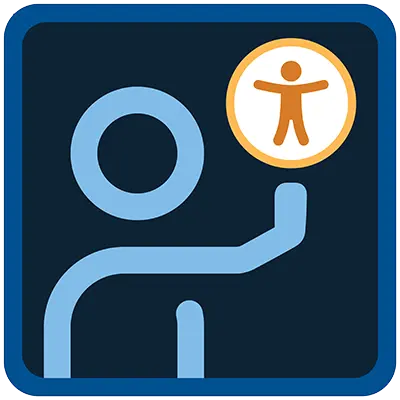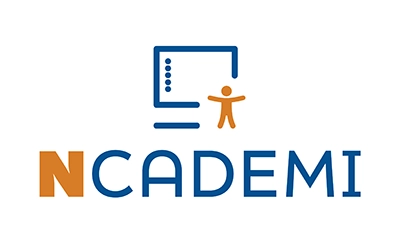
Statement
The state and local educational agencies (SEA and LEAs) establish a leadership structure for the provision and use of high-quality accessible formats of educational materials for students with disabilities who need them.
Intent
Commitment from leadership is essential for initiating and sustaining a coordinated system for providing high-quality accessible formats in a timely manner. This commitment is demonstrated through public messaging, internal structures, and the alignment of roles and responsibilities across the agency. Leadership includes at least one individual with decision-making authority and a cross-disciplinary steering committee. This leadership structure is needed at both the state and local levels to ensure parallel efforts and consistency in coordination.
Critical Components
To effectively address Quality Indicator AF1, the following components should be present:
AF1.1 Steering Committee
A cross-disciplinary steering committee at both the SEA and LEA levels, determined by the size and organizational structure of the agency. Examples of roles and responsibilities include:
- Administration from special education
- Technology (education, information, instruction, and assistive)
- General education
- Special education and related services
- Assessment
- Instructional materials adoption
- Procurement
- Data management
- Students with disabilities and their parents or caregivers
- Additionally, at the state level:
- NIMAC State Coordinator
- AT Act Program representative
- State Parent Center representative
AF1.1 Self-Assessment Scoring Matrix
| Not Started | Emerging | Operationalizing | Scaling & Sustainability |
|---|---|---|---|
| The need for a cross-disciplinary steering committee has not yet been considered. | The SEA and LEAs (“the agency”) are identifying key representatives from each area. Initial outreach is underway to invite members. At the SEA level, staff are reaching out to the NIMAC State Coordinator, the AT Act Program, and the Parent Information Center to invite representatives. | A steering committee has been established with participants from several key areas of the agency. The committee meets periodically and has begun identifying priorities, building shared understanding of the provision of accessible formats under IDEA, and coordinating across divisions. Some perspectives may still be underrepresented. | A fully functioning, cross-disciplinary steering committee within the agency is established. All required roles withing the agency are represented, including students, parents, assessment, and data management. The committee has clearly defined responsibilities, a regular meeting structure, and decision-making or advisory authority. It coordinates with agency leadership and across initiatives. Data, policies, and progress toward ensuring the provision of accessible formats in a timely manner are regularly reviewed. |
The scoring matrix is part of the Quality Indicator Self-Assessment Tools.
AF1.2 Statement of Commitment
A publicly available agency statement of commitment to the provision of accessible formats for students with disabilities who need them. The SEA leads by modeling this statement, which can be adopted or adapted by LEAs.
- An explanation of the agency’s obligation to provide accessible formats under the Individuals with Disabilities Education Act (IDEA), like the provision of other accommodations and supplementary aids and services for students with disabilities.
- A shared vision and goal of a coordinated system for providing high-quality accessible formats of educational materials in a timely manner (see Critical Component AF 2.2 for the definition of “timely manner”).
AF1.2 Self-Assessment Scoring Matrix
| Not Started | Emerging | Operationalizing | Scaling & Sustainability |
|---|---|---|---|
| The provision of a statement of commitment to the provision of accessible formats for students with disabilities has not yet been considered. | The SEA is reviewing legal obligations under IDEA related to the provision of accessible formats for students with disabilities. Leadership is learning about the specific needs of students with disabilities who require accessible formats and coordinating with relevant internal departments and the State NIMAC Coordinator. A draft statement is in development that includes a shared definition and vision. | The SEA has published a statement of commitment with an explanation of the obligation to provide accessible formats alongside the provision of other accommodations and supplementary aids for students with disabilities (e.g., assistive technology, alternative and augmentative communication). Internal awareness of the statement is increasing, and LEAs are informed of the availability of the statement. | The SEA’s statement is publicly posted, frequently referenced, and kept up to date. LEAs adopt or use the SEA statement to inform the development and ongoing updates of their own. |
AF1.3 Clear Role Expectations
Clear expectations regarding roles and responsibilities for ensuring the timely provision of accessible formats.
- Embedded in position descriptions
- Included in performance evaluations
AF1.3 Self-Assessment Scoring Matrix
| Not Started | Emerging | Operationalizing | Scaling & Sustainability |
|---|---|---|---|
| Expectations for ensuring the provision of accessible formats by role and responsibility have not yet been considered. | The SEA and LEAs (“the agency”) are reviewing existing position descriptions to identify where responsibilities related to the provision of accessible formats should be included. Planning is underway to align expectations with relevant roles (e.g., special education, procurement, assistive technology, IT). Leadership is exploring options for job-embedded accessibility responsibilities. | The agency has identified key roles and responsibilities related to the provision of accessible formats and has begun incorporating them into position descriptions across relevant departments (e.g., special education, technology, procurement). Staff in those roles are being supported through training and guidance. The agency is working toward consistent application of responsibilities for the provision of accessible formats across departments and positions. | Clear expectations regarding roles and responsibilities for the provision of accessible formats are fully embedded in all relevant position descriptions within the agency. Hiring, onboarding, and supervision processes reinforce these responsibilities. Staff understand how their role contributes to the agency’s commitment to access for students with disabilities. Expectations are reviewed periodically and updated as needed to reflect evolving practices and policies. |
